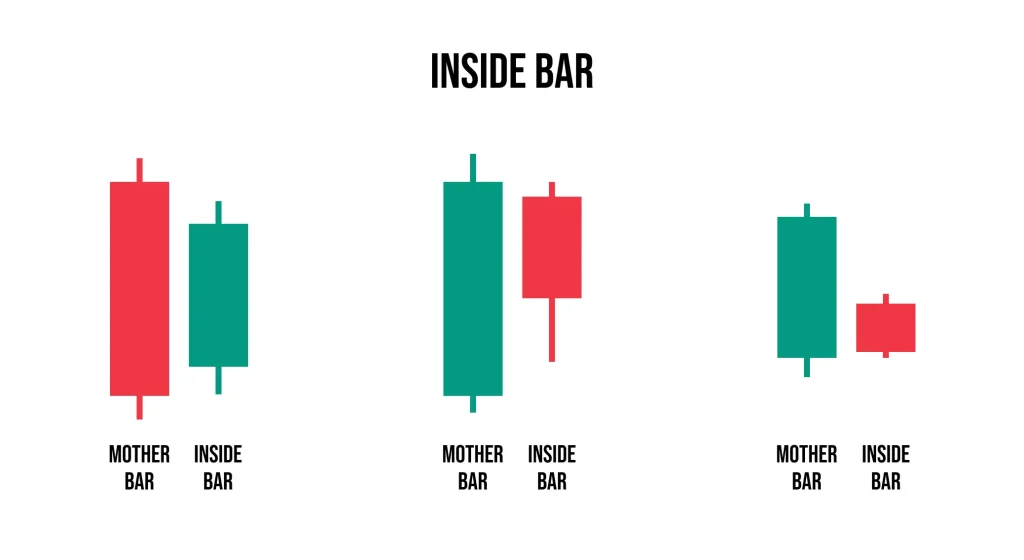
Inside Bar Strategy: A Simple Yet Powerful Trading Technique for All Markets
The inside bar pattern could be exactly what you’ve been missing. It’s clean, easy to spot, and offers a structured way to enter trades with precision. Let’s take a closer look at how the inside bar pattern works and how to trade it.
What Is the Inside Bar Pattern?
The inside bar pattern is a price action pattern where the current bar is entirely within the range of the previous bar (the mother bar). The pattern signals indecision and often precedes strong directional moves. This strategy is used by traders to anticipate potential breakouts following market consolidation. In the market, we recognise two types of inside bars:

- A bullish inside bar typically forms during an uptrend and may suggest continuation.
- A bearish inside bar appears during a downtrend and can indicate further downside.
Why the Psychology Behind Inside Bars Matters?
The inside bar is not just a technical setup. It also reflects the psychology of the market. After a strong move, participants hesitate. Traders take profits, institutions pause, and momentum slows. This contraction in price action shows that the market is preparing for a new phase. Inside bars tend to be most effective in the following scenarios:
- After a momentum candle during a trend.
- At support or resistance levels.
- Ahead of major news or session openings when volatility is low.
A Step-by-Step Approach to the Inside Bar Breakout Strategy
1. Identify the Pattern: Look for a candle whose high and low are fully contained within the range of the previous candle.
2. Plan Your Entry: For better results, focus on inside bars that form after clear signs of market aggression. This could be after a fair value gap or near key support and resistance levels, where price is more likely to react with momentum. Once you’ve identified a valid inside bar, prepare to enter on the breakout with market orders:
- Buy stop limit: Place it just above the high of the inside bar.
- Sell stop limit: Place it just below the low of the inside bar.
This approach helps you enter the market only when the price shows a clear direction, reducing the chances of getting caught in false moves.
3. Set Your Stop Loss: A common approach is to place the stop loss just beyond the opposite side of the inside bar. This gives your trade room to breathe while keeping risk well-defined.
4. Define Your Target: Depending on your strategy and market conditions, you can use:
- A fixed Reward-to-Risk Ratio (e.g. 2:1 or 3:1).
- Nearby support and resistance zones.
- A trailing stop to earn more from trending markets.
How to Avoid False Breakouts?
One of the biggest challenges when trading inside bars is avoiding false signals. Due to its simplicity, this pattern appears frequently on the chart. However, not every setup is worth trading. Many inside bars form in low-quality areas, and entering without proper context can lead to inconsistent results. To improve your accuracy:
- Trade with the trend. Inside bars that form after an aggressive move offer a stronger probability to continue.
- Avoid high-impact news windows. Sudden volatility can disrupt patterns without follow-through.
- Use confluence. Combine inside bars with trendlines, liquidity sweeps, or indicators
- Watch for volume. An increase in volume on the breakout side adds confirmation.
- Try to avoid ranges. Trading in ranges is challenging, as it frequently leads to false breakouts and unreliable signals.
- Use order flow. By analysing order flow, you gain insight into the activity behind the candle, which can significantly improve your breakout accuracy.
Timeframes and Markets Often Associated for Inside Bars
Inside bars appear on all timeframes, but their effectiveness is often greater on higher ones. Daily and four-hour charts tend to provide clearer signals with fewer false breakouts.
Markets where inside bars tend to be highly effective:
- Forex pairs like EURUSD or AUDJPY.
- Equity indices such as the FTSE 100 or NASDAQ.
- Cryptocurrencies, especially Bitcoin and Ethereum.
The key is to combine the pattern with strong context. An inside bar alone is not enough.
All information provided on this site is intended solely for educational purposes related to trading on financial markets and does not serve in any way as a specific investment recommendation, business recommendation, investment opportunity analysis or similar general recommendation regarding the trading of investment instruments. FTMO only provides services of simulated trading and educational tools for traders. The information on this site is not directed at residents in any country or jurisdiction where such distribution or use would be contrary to local laws or regulations. FTMO companies do not act as a broker and do not accept any deposits.
About FTMO
FTMO has developed a two-step evaluation process to find trading talents. Upon successful completion, you may be eligible for an FTMO Rewards Account with a balance of up to $200,000 in simulated funds. How does it work?





